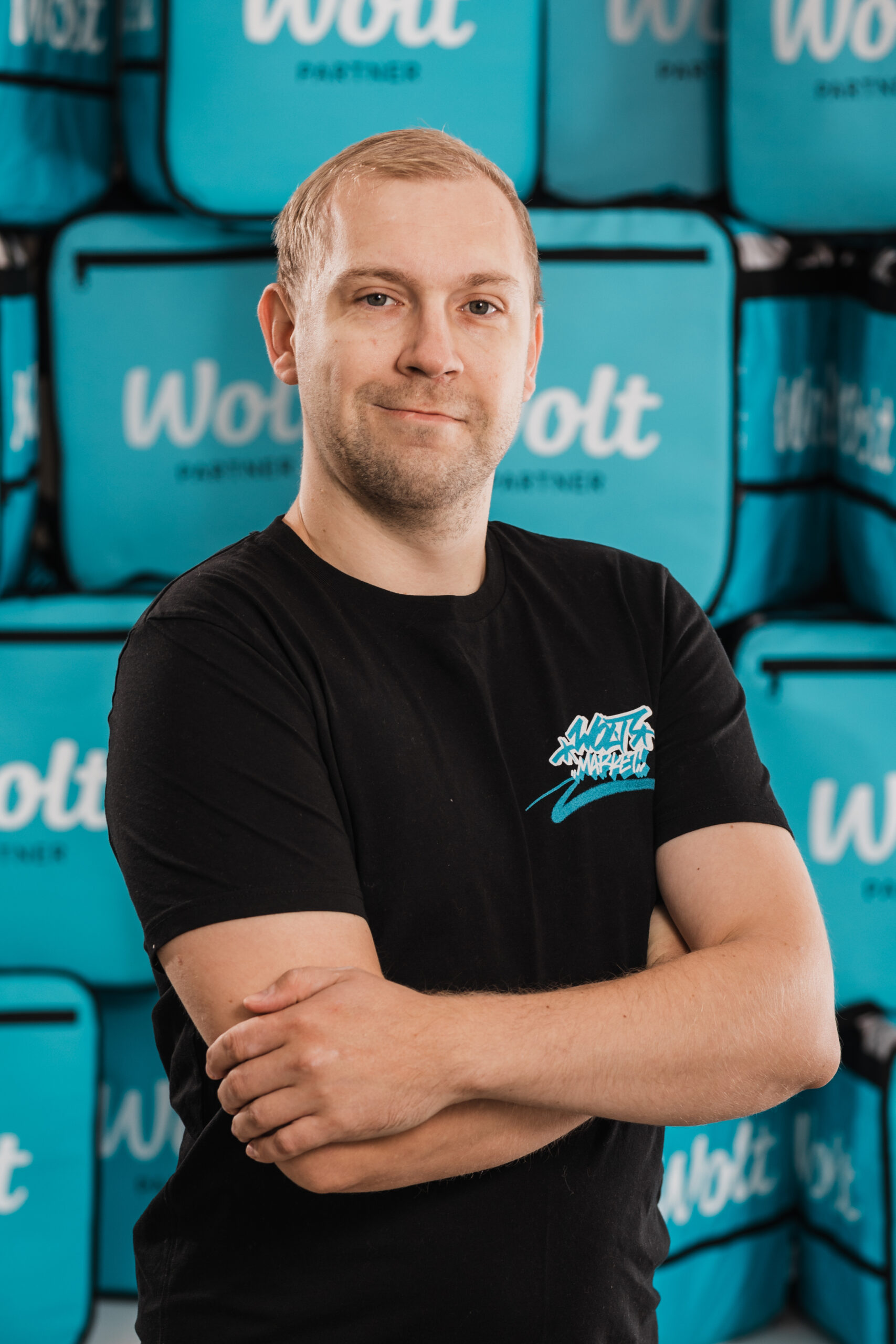Wolt Market: Retail does not work without EDI
Mar 27, 2024

From the very beginning, Wolt Market recognized that scaling a modern retail business requires automation – and Electronic Data Interchange (EDI) quickly became the answer. By replacing manual Excel files and emailed orders with EDI, Wolt eliminated time-consuming routines and human errors, laying the foundation for fast, accurate, and seamless cooperation with suppliers.
As the business volumes grew, so did the volume of orders and manual work. Therefore, solutions for automating the ordering process were sought. Internal data flows were mapped out, and the market was explored. Consultations were held with business partners about their experiences with using EDI (Electronic Data Interchange).
Scaling Retail with EDI Instead of Manual Work
According to Madis Varend, Wolt Market’s inventory manager, it was clear as a day that automating routine operations was necessary for scaling the business. The solution they started to look for had to achieve four objectives:
- Save time in the ordering process
- Save time and money in the invoice handling process
- Minimize or prevent errors
- Automate processes
One option on the table was to develop the system in-house. However, it was necessary to consider that the solution would be needed in more than 20 countries, and the investment would have been significant. Wolt’s internal development focuses on areas related to the core business and on creating the maximum value. Thus, it was decided to outsource this supporting function and start with the help of existing EDI service providers.
Choosing Telema EDI for Multi-Country Growth
Wolt Market’s activities are not limited to Estonia; they also have stores in Latvia and Lithuania, and in 20 other countries. When looking for an EDI solution in the three Baltic countries, two potential partners emerged. Next, it was necessary to know the technical capabilities for implementing the solution and whether the potential partner had the required competence. Wolt’s ERP software, which was one of the factors, is built by Wolt itself.

Varend noted that Telema stood out for its open and consultative approach:
“As a customer, we might say that we want a specific solution. But being able to constructively discuss different options with the service provider helps to bring the customer’s real needs to light. Honest and open communication about the real issues leads us to better solutions.”
The choice was made easier by the fact that, unlike a competitor who offered the service only locally in each country, Telema was ready to offer solutions for Wolt’s problems in all three countries using the same project team. This avoided the constant “reinvention of the wheel,” i.e., implementing the same solution with new partners and a new team.
EDI Orders: Faster Deliveries, Fewer Errors
Retail chains often start implementing EDI from the invoicing side to make the goods receipt process faster and error-free. However, Wolt Market made a conscious decision to first automate the sending of orders.
According to Varend, ensuring the availability of goods is a prerequisite for a good customer experience:
“It’s very important that suppliers know as quickly and accurately as possible (without handling and entry errors) what we want and when we want it. When there is EDI between our systems and the supplier system, the processing time for the order essentially disappears for the supplier, and we receive the ordered goods faster.”
Varend believes that ordering via EDI gives Wolt a better position to negotiate delivery terms and times – today, it is possible to order for tomorrow or the day after. Speeding up the handling of orders helps to reduce the size of buffer stocks, which in turn affects both the availability of goods and releases capital tied up in inventory.
EDI Invoices: Transparency and Accuracy in Finance
Automating the invoicing was more challenging, as at the start of the EDI project, Wolt’s internal system did not yet support invoice reception. While adding the order module went smoothly, invoicing had many nuances that had to be thought through and planned. For example, issues with packaging and VAT, as well as handling credit invoices. In addition, when comparing invoices with orders, i.e., their confirmation process and subsequent payment – the whole process, according to Varend, is much more complex.
Before moving to EDI invoices, Wolt was dependent on the discipline of suppliers. For example, it was challenging to ensure that invoices arrived on time and Wolt had no overview of document traffic. Today, the invoice handling process in Wolt has been automated.

Full Visibility Across the Supply Chain with EDI
One of the main benefits of adopting EDI is the resulting transparency. EDI allows Wolt Market control and an overview of the process. Varend comments:
“With the switch to the EDIBuyer solution, we started to understand better what we ordered, what was invoiced, what the differences and gaps were. Visibility and the ability to identify bottlenecks emerged. The EDI system has a log where we can track where a problem occurred, by whom, and when, and we can start solving it together with the supplier or Telema customer support.”
Looking into the future, Wolt sees several possibilities for further automation. For example, it could work in a way that they enter data to the system, which then is able to forecast the future – what customers will buy, when, how much, and in which season. This way, Wolt will achieve customer satisfaction by knowing in advance what they want, while also reducing food waste.
EDI Investment That Quickly Pays Off
The EDI implementation project brings not only benefits but also an investment of time and resources for the company. When asked whether the EDI project has been profitable for Wolt, Madis Varend doesn’t take long to answer:

“We have measured internally – the project definitely pays off; otherwise, we would not have undertaken it in the first place. The process of ordering and invoicing means both direct and indirect costs for companies. When considering which of these costs can be fully eliminated or significantly reduced through automation, the economic benefit of switching to EDI becomes obvious.”
Varend emphasizes the importance of considering administrative costs and the costs of correcting errors, especially if errors escalate down the supply chain. He points out that a single erroneous credit invoice can cause significant confusion in invoicing, making problem identification without an EDI system a task that could take hours or even weeks.
Partnership-Driven Automation for the Whole Supply Chain
Wolt has approached automation from the viewpoint of the total benefit of the supply chain. Sometimes companies only consider their own perspective, but Varend advocates for looking at the bigger picture:
“It would be very easy to look at things only from our own perspective. Instead, we should think about what’s a good decision for the entire supply chain – from our suppliers’ point of view, ours, and our customers’. This was also one of the reasons why we started the EDI project with the automation of orders – it had a quick effect on the entire supply chain and thanks to improved product availability, end-customer satisfaction also increased.”
Collaboration in the supply chain is very important for Wolt. The goal is to create long-term relationships with partners that last not just years, but decades. Trust and understanding are crucial, helping to successfully cope and grow together.
Wolt Market
Wolt is a Finnish technology company operating in 26 countries and over 500 cities, offering products from more than 130,000 merchants with the help of more than 200,000 courier partners to over 33 million registered users. Wolt was founded in 2014, and today it employs more than 10,000 people. Wolt uses its own developed system for warehouse and financial software. Telema’s services include the Telema EDIBuyer, through which goods are ordered from more than 130 suppliers. As of now, more than 7,000 document-handling processes are automated monthly, and this volume is increasing month by month.
- If you are interested in collaborating with Wolt to create a sales channel or to see your product in Wolt’s assortment, contact them at Madis.Varend@Wolt.com.
- Read more about the Telema EDIBuyer product.